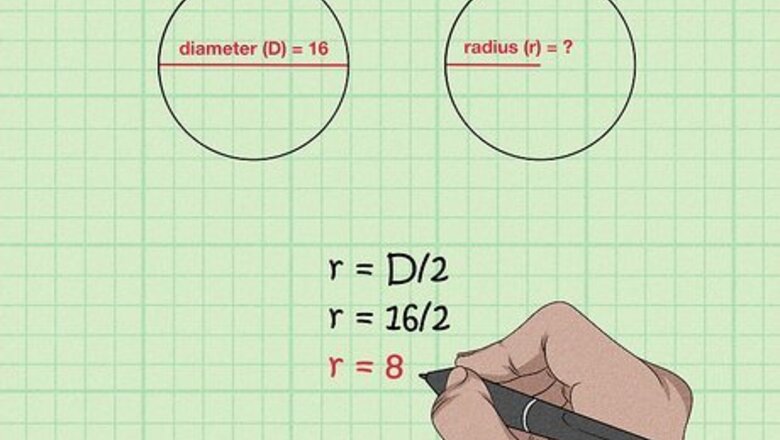
views
Using Radius Calculation Formulas
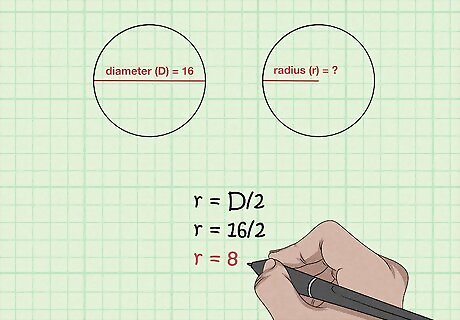
Find the radius if you know the diameter. The radius is half the diameter, so use the formula r = D/2. This is identical to the method used for calculating the radius of a circle from its diameter. If you have a sphere with a diameter of 16 cm, find the radius by dividing 16/2 to get 8 cm. If the diameter is 42, then the radius is 21.
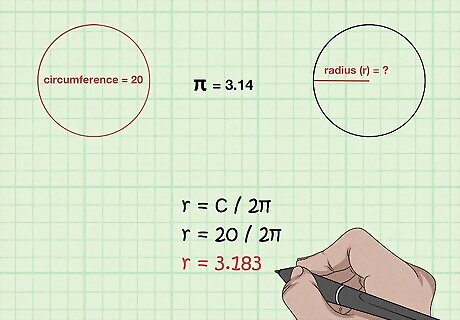
Find the radius if you know the circumference. Use the formula C/2π. Since the circumference is equal to πD, which is equal to 2πr, dividing the circumference by 2π will give the radius. If you have a sphere with a circumference of 20 m, find the radius by dividing 20/2π = 3.183 m. Use the same formula to convert between the radius and circumference of a circle.
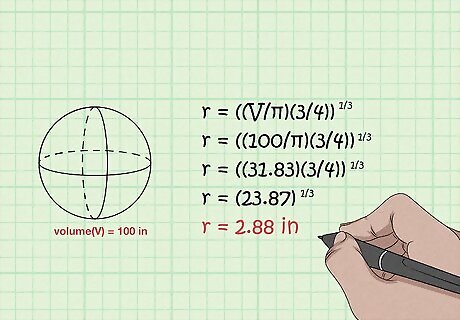
Calculate the radius if you know the volume of a sphere. Use the formula ((V/π)(3/4)). The volume of a sphere is derived from the equation V = (4/3)πr. Solving for the r variable in this equation gets ((V/π)(3/4)) = r, meaning that the radius of a sphere is equal to the volume divided by π, times 3/4, all taken to the 1/3 power (or the cube root.) If you have a sphere with a volume of 100 inches, solve for the radius as follows: ((V/π)(3/4)) = r ((100/π)(3/4)) = r ((31.83)(3/4)) = r (23.87) = r 2.88 in = r

Find the radius from the surface area. Use the formula r = √(A/(4π)). The surface area of a sphere is derived from the equation A = 4πr. Solving for the r variable yields √(A/(4π)) = r, meaning that the radius of a sphere is equal to the square root of the surface area divided by 4π. You can also take (A/(4π)) to the 1/2 power for the same result. If you have a sphere with a surface area of 1,200 cm, solve for the radius as follows: √(A/(4π)) = r √(1200/(4π)) = r √(300/(π)) = r √(95.49) = r 9.77 cm = r
Defining Key Concepts

Identify the basic measurements of a sphere. The radius (r) is the distance from the exact center of the sphere to any point on the surface of the sphere. Generally speaking, you can find the radius of a sphere if you know the diameter, the circumference, the volume, or the surface area. Diameter (D): the distance across the sphere – double the radius. Diameter is the length of a line through the center of the sphere: from one point on the outside of the sphere to a corresponding point directly across from it. In other words, the greatest possible distance between two points on the sphere. Circumference (C): the one-dimensional distance around the sphere at its widest point. In other words, the perimeter of a spherical cross-section whose plane passes through the center of the sphere. Volume (V): the three-dimensional space contained inside the sphere. It is the "space that the sphere takes up." Surface Area (A): the two-dimensional area on the outside surface of the sphere. The amount of flat space that covers the outside of the sphere. Pi (π): a constant that expresses the ratio of the circle's circumference to the circle's diameter. The first ten digits of Pi are always 3.141592653, although it is usually rounded to 3.14.

Use various measurements to find the radius. You can use the diameter, circumference, volume, and surface area to calculate the radius of a sphere. You can also calculate each of these numbers if you know the length of the radius itself. Thus, to find the radius, try reversing the formulas for these components' calculations. Learn the formulas that use the radius to find diameter, circumference, volume, and surface area. D = 2r. As with circles, the diameter of a sphere is twice the radius. C = πD or 2πr. As with circles, the circumference of a sphere is equal to π times the diameter. Since the diameter is twice the radius, we can also say that the circumference is twice the radius times π. V = (4/3)πr. The volume of a sphere is the radius cubed (times itself twice), times π, times 4/3. A = 4πr. The surface area of a sphere is the radius squared (times itself), times π, times 4. Since the area of a circle is πr, it can also be said that the surface area of a sphere is four times the area of the circle formed by its circumference.
Finding the Radius as the Distance Between Two Points

Find the (x,y,z) coordinates of the central point of the sphere. One way to think of the radius of a sphere is as the distance between the point at the center of the sphere and any point on the surface of the sphere. Because this is true, if you know the coordinates of the point at the center of the sphere and of any point on the surface, you can find the radius of the sphere simply by calculating the distance between the two points with a variant of the basic distance formula. To begin, find the coordinates of the sphere's center point. Note that because spheres are three-dimensional, this will be an (x,y,z) point rather than an (x,y) point. This process is easier to understand by following along with an example. For our purposes, let's say that we have a sphere centered around the (x,y,z) point (4, -1, 12). In the next few steps, we'll use this point to help find the radius.
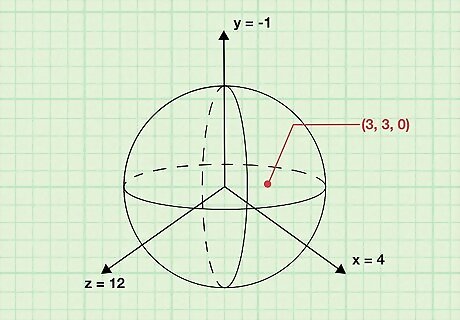
Find the coordinates of a point on the surface of the sphere. Next, you'll need to find the (x,y,z) coordinates of a point on the surface of the sphere. This can be any point on the surface of the sphere. Because the points on the surface of a sphere are equidistant from the center point by definition, any point will work for determining the radius. For our example problem, let's say that we know that the point (3, 3, 0) lies on the surface of the sphere. By calculating the distance between this point and the center point, we can find the radius.

Find the radius with the formula d = √((x2 - x1) + (y2 - y1) + (z2 - z1)). Now that you know the center of the sphere and a point on the surface, calculating the distance between the two will find the radius. Use the three-dimensional distance formula d = √((x2 - x1) + (y2 - y1) + (z2 - z1)), where d equals distance, (x1,y1,z1) equals the coordinates of the center point, and (x2,y2,z2) equals the coordinates of the point on the surface to find the distance between the two points. In our example, we would plug in (4, -1, 12) for (x1,y1,z1) and (3, 3, 0) for (x2,y2,z2), solving as follows: d = √((x2 - x1) + (y2 - y1) + (z2 - z1)) d = √((3 - 4) + (3 - -1) + (0 - 12)) d = √((-1) + (4) + (-12)) d = √(1 + 16 + 144) d = √(161) d = 12.69. This is the radius of our sphere.
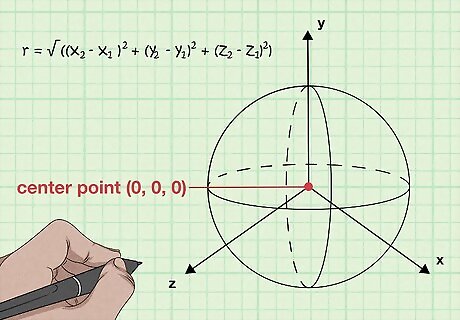
Know that, in general cases, r = √((x2 - x1) + (y2 - y1) + (z2 - z1)). In a sphere, every point on the surface of the sphere is the same distance from the center point. If we take the three-dimensional distance formula above and replace the "d" variable with the "r" variable for radius, we get a form of the equation that can can find the radius given any center point (x1,y1,z1) and any corresponding surface point (x2,y2,z2). By squaring both sides of this equation, we get r = (x2 - x1) + (y2 - y1) + (z2 - z1). Note that this is essentially equal to the basic sphere equation r = x + y + z which assumes a center point of (0,0,0).

















Comments
0 comment